Behind Thousands of Performances Each Year, Stage Crew Students Shine
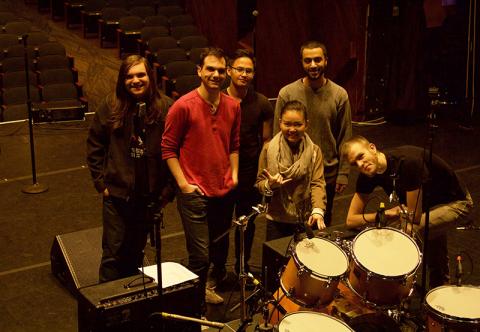
Several Berklee stage crew students take a quick break to pose for a photo while setting up for a performance by Berklee’s Bob Marley Ensemble with special guest Vivien Goldman on February 2, 2017.
Photo by Mike Keefe-Feldman
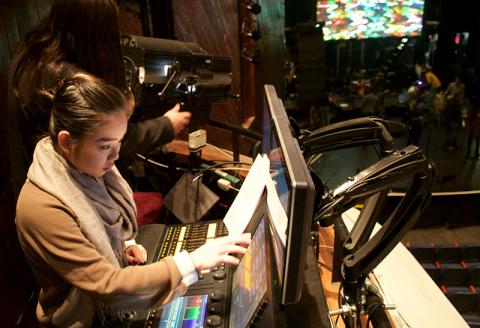
Student Angie Nguyen leads the lighting crew for the performance of Bob Marley’s Exodus in the Berklee Performance Center. Berklee stage crew students have gone on to work for top tours (the Rolling Stones, Katy Perry, Pearl Jam, Beyoncé) and leading production companies such as Live Nation and Disney, among others.
Photo by Mike Keefe-Feldman

Production manager Dave Wentling trains stage crew students Thaer Bader and Nana Tsao. “Take your ears for a walk,” Wentling says, advising the students to explore sound at different locations throughout a venue. Wentling passes along tips such as “the frequencies the neighbors complain about” and how to work with a trumpet’s “hot spot” in live settings.
Photo by Mike Keefe-Feldman

Stage crew student Visnja Begovic says working crew has not only advanced her technical knowledge, but, as a singer, given her a newfound appreciation for all of those working behind the scenes. “It teaches you how to have patience and respect for the people who are working for you.”
Photo by Mike Keefe-Feldman
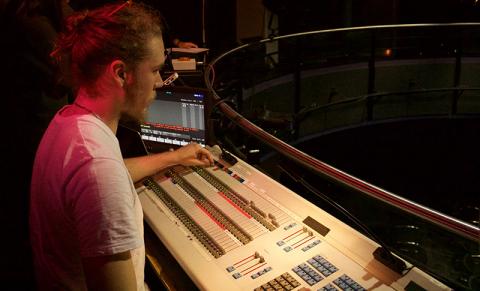
Student Caio Moskalkoff practices programming lights in Berklee’s David Friend Recital Hall.
Photo by Mike Keefe-Feldman
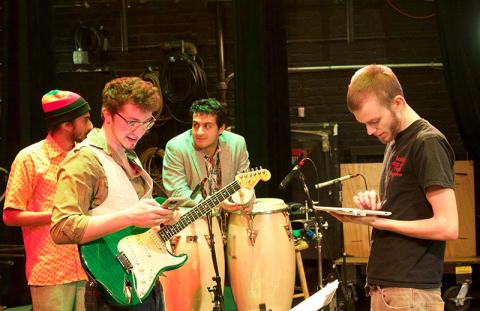
Jay Hamilton leads the Marley Ensemble through soundcheck, getting all levels just right for the concert. After graduating, Hamilton hopes to pursue a master’s degree at Berklee’s Valencia, Spain campus. “The more experience you get doing this kind of thing, the better you get,” Hamilton says. “There’s only so much you can do within your own head, so watching all my supervisors work and taking things from their workflow and adding it to my own has been very valuable.”
Photo by Mike Keefe-Feldman
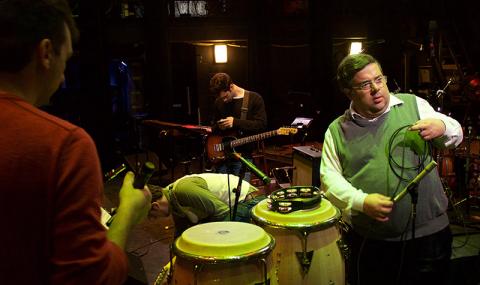
Production manager Alejo Planchart works with the stage-crew students, testing each mic on stage. One of his work-study students, Fares Btoush, notes, “Alejo likes to say, ‘If it works, the manager is invisible. If it doesn’t work, it’s all his fault.’”
Photo by Mike Keefe-Feldman
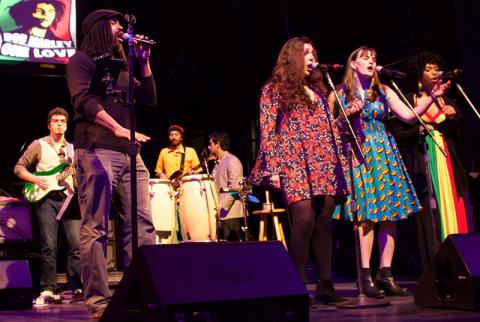
The Marley concert is a success for the stage crew. The audience doesn’t notice the crew’s presence nor the work that went into making the show sound and look great.
Photo by Mike Keefe-Feldman
Building from a low reggae rumbling to a crescendo, the opening bars of Bob Marley’s “Natural Mystic” filled the Berklee Performance Center as Berklee’s Bob Marley Ensemble, directed by Matt Jenson, settled into a groove during a recent performance of Marley’s Exodus album. The audience basked in the sound, stage lighting, and a psychedelic-tinged slideshow backdrop as acclaimed author Vivien Goldman came on stage to narrate the punky reggae party that soon commenced.
The concert was one of more than approximately 2,700 events that Berklee stages over the course of the year, and like the rest, much of the work that went into producing a great evening for the audience took place behind the scenes, and came to fruition thanks to Berklee’s sizable team of stage crew work-study students.
A Job That's Like Taking a Course
For the Marley show, that crew included students Fares Btoush, the stage manager who worked on monitors; Angie Nguyen, who ran the lighting operation; network supervisor Yoga Bagaspati; spotlight operators Joe D’abate and Parker Jackson; and student crew chief Jay Hamilton. In setup and soundcheck, these students made a great show possible—and beyond that, they exercised skills that are much in demand in today’s thriving live-performance industry.
During soundcheck, Hamilton, a sixth-semester dual major in music production and engineering and electronic production and design from Ithaca, New York, carefully tested each microphone, each drum, and the PA system while responding to requests from the band. Hamilton says that working with stage crew gives him an opportunity to practice at night many of the skills he learns in the classroom during the day.
“It’s more like taking a class than taking a job sometimes,” Hamilton says.
Hamilton first started working front-of-house audio in middle school. His fellow crew member, Btoush, a seventh-semester oud player from Amman, Jordan, had minimal experience prior to joining the stage crew team but a deep willingness to learn. Coming in with a performer’s perspective, he credits Berklee’s staff of production managers with providing the tools and information necessary to understand a live performance in a more holistic sense.
“A job is what you get paid for,” Btoush says, “but on crew, you’re interacting, seeing things, doing things, and learning.”
Learning from Road Warriors
Among the staff that Hamilton, Btoush, and their peers learn from is production manager Dave Wentling, a veteran road warrior who spent 25 years on crew, touring with large-scale productions for artists such as Natalie Cole, Tony Bennett, the Everly Brothers, the Gypsy Kings, Hall & Oates, and many more. In his office in the David Friend Recital Hall, which is adorned with autographed tour photos of everyone from Buddy Guy to the Four Tops, Wentling says that he and his fellow production team staff enlist more than 70 work-study students to pull off the thousands of performances that Berklee hosts each year.
“We spend hours with them teaching them how to wire the stage, use the mixing board, set up mic stands, and so on,” Wentling says, as well as training on “how to recognize frequencies.” Wentling advises his students to develop pet names for frequencies—“harsh, muffly, shrill, boxey, etc.”—to help them remember when an adjustment is needed at a moment’s notice.
For some, this training will inform their career as a performer; after all, Wentling notes, if one is attuned to the concerns of the crew, a performer is less likely to fall into the practices that agitate crews, such as showing up for a gig without a stage plot. Wentling says being prepared is the key to developing a “we’re all in this together” team spirit that tends to produce shows that sound and look great.
For others, the training may well turn into a career. For example, 2010 Berklee alumnus Eric Marchwinski has worked as a lighting programmer, director, and designer, as well as a video programmer, on tours for artists such as the Rolling Stones, Katy Perry, Usher, Pearl Jam, and Beyoncé. Other alumni have taken on production roles at companies such as Live Nation, American Public Media, and high-profile events such as the Olympics, the Grammys, and the Super Bowl.
Forging Lifelong Bonds through Teamwork
Among those who turned crew work into a career is Marc Malanca B.M. '14. After graduating, Malanca took a job as a lighting technician at Disney World, where he works on daily shows tied to popular Disney characters from films and shows such as The Little Mermaid, Jake and the Neverland Pirates, Sophia the First, Doc McStuffins, and Beauty and the Beast.
Malanca says he enjoys the creativity involved in lighting, which, as a guitarist, he thinks of in much the same way he does playing an instrument.
“There’s a lighting equivalent to the tambourine,” for example, Malanca says, attributing his early success right out of college to a level of professionalism he found while working—and eventually training students—at Berklee, where he says he learned much about lighting from Ryan Jones, associate director of production at the college.
Malanca points to a solidarity formed among his stage crew friends at Berklee—a network that he says remains strong to this day. That connection is clearly playing out yet again with the current cohort of stage crew work-study students.
As Hamilton puts it, “We’re good friends. It’s a supportive community. There’s a lot of ‘Hey, I need help with this’ and people just step up and do it.”
Night after night of putting on professional performances and long after the audience applause has faded, that bond forged in the trenches of teamwork is strengthened.
